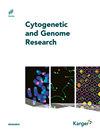Minimal Critical Region and Genes for a Typical Presentation of Langer-Giedion Syndrome
IF 1.7
4区 生物学
Q4 CELL BIOLOGY
引用次数: 1
Abstract
Langer-Giedion syndrome (LGS) is caused by a contiguous deletion at 8q23q24, characterized by exostoses, facial, ectodermal, and skeletal anomalies, and, occasionally, intellectual disability. LGS patients have been diagnosed clinically or by routine cytogenetic techniques, hampering the definition of an accurate genotype-phenotype correlation for the syndrome. We report two unrelated patients with 8q23q24 deletions, characterized by cytogenomic techniques, with one of them, to our knowledge, carrying the smallest deletion reported in classic LGS cases. We assessed the pathogenicity of the deletion of genes within the 8q23q24 region and reviewed other molecularly confirmed cases from the literature. Our findings suggest a 3.2-Mb critical region for a typical presentation of the syndrome, emphasizing the contribution of the TRPS1, RAD21, and EXT1 genes’ haploinsufficiency, and facial dysmorphisms as well as bone anomalies as the most frequent features among patients with LGS. We also suggest a possible role for the CSMD3 gene, whose deletion seems to contribute to central nervous system anomalies. Since studies performing such correlation for LGS patients are limited, our data contribute to improving the genotype-phenotype characterization for LGS patients.Langer-Giedion综合征典型表现的最小临界区和基因
Langer-Giedion综合征(LGS)是由8q23q24的连续缺失引起的,其特征是外泌体、面部、外胚层和骨骼异常,偶尔还有智力残疾。LGS患者已通过临床或常规细胞遗传学技术进行诊断,这阻碍了该综合征基因型-表型相关性的准确定义。我们报告了两例不相关的8q23q24缺失患者,其特征是细胞基因组技术,据我们所知,其中一例携带经典LGS病例中报告的最小缺失。我们评估了8q23q24区域内基因缺失的致病性,并回顾了文献中其他分子证实的病例。我们的研究结果表明,该综合征的典型表现有一个3.2-Mb的临界区,强调TRPS1、RAD21和EXT1基因单倍性不足、面部畸形和骨骼异常是LGS患者最常见的特征。我们还提出了CSMD3基因的可能作用,其缺失似乎会导致中枢神经系统异常。由于对LGS患者进行这种相关性的研究有限,我们的数据有助于改善LGS患者的基因型-表型特征。
本文章由计算机程序翻译,如有差异,请以英文原文为准。
求助全文
约1分钟内获得全文
求助全文
来源期刊

Cytogenetic and Genome Research
生物-细胞生物学
CiteScore
3.10
自引率
5.90%
发文量
25
审稿时长
1 months
期刊介绍:
During the last decades, ''Cytogenetic and Genome Research'' has been the leading forum for original reports and reviews in human and animal cytogenetics, including molecular, clinical and comparative cytogenetics. In recent years, most of its papers have centered on genome research, including gene cloning and sequencing, gene mapping, gene regulation and expression, cancer genetics, comparative genetics, gene linkage and related areas. The journal also publishes key papers on chromosome aberrations in somatic, meiotic and malignant cells. Its scope has expanded to include studies on invertebrate and plant cytogenetics and genomics. Also featured are the vast majority of the reports of the International Workshops on Human Chromosome Mapping, the reports of international human and animal chromosome nomenclature committees, and proceedings of the American and European cytogenetic conferences and other events. In addition to regular issues, the journal has been publishing since 2002 a series of topical issues on a broad variety of themes from cytogenetic and genome research.
 求助内容:
求助内容: 应助结果提醒方式:
应助结果提醒方式:


